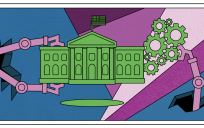What do you do when a chunk of money falls from the sky?
State and local governments are figuring out how to answer a version of this question after the American Rescue Plan set aside $350 billion in aid to help with COVID-19 recovery. It isn’t a bad problem to have, but it can be challenging to navigate.
Wayne County, Michigan, is using the big picture to guide its usage of funds. The county received $340 million from the COVID-19 relief bill, which is 60-65% of its entire general fund. That’s “big money,” as Chief Financial Officer Hughey Newsome said, so it benefits them to “think big.”
Thinking big means integrating long-term goals and visions, such as, “What does the county look like today? What could it look like tomorrow? And how do we use the funds as a way to close the [equity] gap and be transformative?” Newsome said at GovLoop’s online training Wednesday.
The pandemic relief money is more than a budget safety net; it’s more than recompense for lost revenue. The $340 million that Wayne County received will be used to picture a more equitable future as well, Newsome said.
“It’s the biggest effort [of] a programmatic approach to closing something as broad as inequities in the deployment of services and goods,” Newsome said.
One of the main obstacles, however, for Wayne County is ensuring it has the right communication model to implement funding initiatives. Governments often use traditional models, but COVID-19 has changed the game.
“You have to engage with new partners,” Newsome said, and that goes beyond private sector partners. It’s critical to get community members at the table as you plan how to use the funds, as opposed to after the plan is determined, Newsome said. For instance, the county learned the importance of engaging religious leaders to communicate with constituents.
Unqork, a software platform provider, also found that nonprofits are critical partners for effectively distributing rental assistance, said Clint Buytenhuys, Unqork’s Regional Vice President of Public Sector. The company has worked with jurisdictions nationwide to provide low-code solutions for rent relief. “It’s very important to recognize the work taking place there,” Buytenhuys said.
As high as 75% of applications for rental assistance are completed on a mobile device. Agencies should partner with technology providers that enable them to develop a software application once and deploy it on a number of devices, without having to manually refactor features for every interface, Buytenhuys said. With Unqork’s low-code capabilities, agencies can build complex solutions for rental assistance in as little as 8 days.
The American Rescue Plan has given state and local agencies a considerable boost to modernize and improve their services and technologies. It can be a strategic opportunity to better serve all constituents – particularly marginalized and vulnerable ones – in the near future.
This online training was brought to you by:






Leave a Reply
You must be logged in to post a comment.